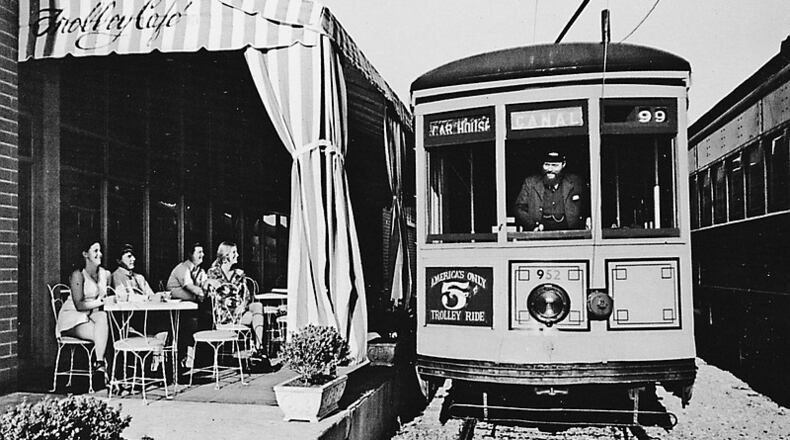In the early 1900s, before the advent of the automobile, Chattanoogans traversed the city on the streetcar, a train-like carrier propelled on tracks by electricity.
Residents of the St. Elmo neighborhood, for instance, could hop on the streetcar and head north, past the Lookout Mountain Incline Railway into downtown, where tracks were laid on roadways such as Market Street and McCallie Avenue, among others.
From there, they could take a streetcar as far east as Missionary Ridge or head north to Signal Mountain. Passengers could even ride a streetcar into Georgia all the way to Chickamauga Battlefield, according to a 1913 Chattanooga streetcar map found in David Steinberg’s “Chattanooga’s Transportation Heritage,” a book that outlines the history of transportation in the city from the late 1800s to today.
“Imagine if everyone was that well connected to transportation that you could be able to go from the top of Lookout Mountain to the top of Signal Mountain and change the streetcar once,” Justin Strickland, public space coordinator for the city’s transportation division and enthusiast of the city’s streetcar history, said in an interview.
“Every neighborhood that lies within the confines of Signal Mountain, Lookout Mountain and Missionary Ridge,” Strickland continued, “every neighborhood had a streetcar line, adjacent or going through it.”
Chattanooga’s transit system today is much different.
The streetcars, as a system of public transit, have since been replaced by buses operated by the Chattanooga Area Regional Transportation Authority, or CARTA. No CARTA lines go up Signal Mountain. The Lookout Mountain incline is the only relic of the old streetcar system, Steinberg said in a phone interview from New York, where he lives. Steinberg operated a streetcar in the 1970s that once toured the grounds of Terminal Station, now the site of the Chattanooga Choo-Choo Hotel.
Credit: University of Kentucky Libraries Special Collections Research Center
Credit: University of Kentucky Libraries Special Collections Research Center
The St. Elmo streetcar line that once ran by the Lookout incline no longer exists. By the late 1940s, most of the streetcar tracks across the city were ripped up to make room for vehicles. Today, a portion of where the tracks were near the Lookout incline is St. Elmo Avenue.
Like in many U.S. cities, most Chattanoogans now get around in their own personal vehicles. Steinberg said he’s old enough to remember a time when he was a child in the early 1940s when the car wasn’t as prevalent as a means of transportation in Chattanooga. He said the streetcars “were packed” full of people at the time.
“There were elevated platforms where you could wait and not get hit by a car passing on either side, and the streetcar would screech as it came around the bend,” Steinberg said. “That’s how you knew it was coming.”
That was at the tail end of the Chattanooga streetcar’s lifespan, when Steinberg said the rails weren’t greased as often.
“In the end, they didn’t care how it ran,” Steinberg said.
The demise
At the peak of Chattanooga’s streetcar system in the early 1900s, the streetcars were operated by a private company called the Chattanooga Railway & Light Co.
By the end of the 1940s, after ownership changed hands a few times, streetcars in Chattanooga were completely replaced by buses. Personal vehicles for everyday transportation started to become more commonplace, a trend that had been growing throughout the nation since the 1920s, Steinberg said.
Conspiracy theories have emerged since then, Vox reported in 2015, that automobile interests bought up streetcar companies in cities across the United States to intentionally sabotage them, as famously depicted in Disney’s 1988 film “Who Framed Roger Rabbit.”
For Chattanooga at least, the demise of the streetcar isn’t as nefarious. Buses became easier and cheaper to operate as automobile engine technology advanced, Steinberg said.
“They realized you can take that same motor and put it on a bus and on wheels,” Steinberg said. “There was a lot of advantage to that because the streetcar could only go where the rails took it.”
If a company wanted to change a route for a streetcar, it was expensive to lay new tracks, Steinberg said, as opposed to a bus, not confined to the rail, simply taking a different route.
“You just put a box on four wheels,” Steinberg said. “The bus could go wherever you want. Change the route tomorrow. You could go down this street rather than the other street. The streetcar was limited.”
Credit: Ben Sessoms
Credit: Ben Sessoms
Transit today
In the 1970s, CARTA began operating all public transit in the city and still does. When comparing ridership from the streetcars in the early 1900s to today’s CARTA buses, it’s clear public transit is no longer preferred by Chattanoogans.
In the 1890s — when Chattanooga’s population was roughly 30,000, according to the U.S. Census Bureau — the streetcar system carried 2.5 million passengers annually, according to Steinberg’s book. Despite the city’s population increasing to nearly 185,000 since then, CARTA’s annual ridership is about 1.7 million, according to data provided by CARTA officials.
Public transit from the river to the ridge was a more vital part of living in the city 100 years ago, Eric Myers, executive director of the Chattanooga Design Studio, said in an interview.
“Those east-west connections were so vital for so many people that either came downtown to go to their church and worship or go to work,” Myers said. “A streetcar coming by your neighborhood every 10 or 15 minutes was a really convenient way to live.”
The introduction of the freeway system in the 1960s and widening of roadways to accommodate the car, Myers said, changed the way Chattanoogans live.
“It evolved into a much more changed transit system to what we have today,” Myers said. “I think it presents us with challenges.”
The city should work toward having the bus CARTA system operate more efficiently with higher frequency stops, he said.
Chattanooga officials should invest more in CARTA so the agency can make changes that make riding the bus more desirable, Jon Jon Wesolowski, a Chattanooga resident who advocates for more robust public transit, said in an interview. The city’s budget this year allocates $5.8 million to CARTA, 1.71% of all city expenses.
“There’s this weird chicken-or-the-egg situation where until you make something good, ridership numbers probably won’t go up,” said Wesolowski, a Bushtown-Glenwood Community Advisory Committee member. “But if ridership numbers aren’t going up, people aren’t really motivated to spend money to make something good.”
Wesolowski said he supports CARTA, however, and thinks there should be more public support behind the agency.
“They need more funding,” he said. “They need more muscle behind them.”
Steinberg said he is hopeful cities across the nation will begin seeing streetcars and other commuter rail lines again, citing cities such as Atlanta and Charlotte that have invested more in public transit in recent years. People today are more concerned about the pollution of gas vehicles and want more environmentally friendly options such as the streetcar, he said.
“It’s coming back,” Steinberg said. “Yes, it is coming back.”
Contact Ben Sessoms at bsessoms@timesfreepress.com or 423-757-6354.
Credit: Chattanooga Times Free Press
Credit: Chattanooga Times Free Press
MEET OUR PARTNER
Today’s story comes from our partner, Chattanooga Times Free Press, which serves readers in Southeast Tennessee, Northwest Georgia and Northeast Alabama. Visit them at timesfreepress.com or on Twitter @TimesFreePress.
If you have any feedback or questions about our partnerships, you can contact Senior Manager of Partnerships Nicole Williams via email at nicole.williams@ajc.com.
About the Author
The Latest
Featured






